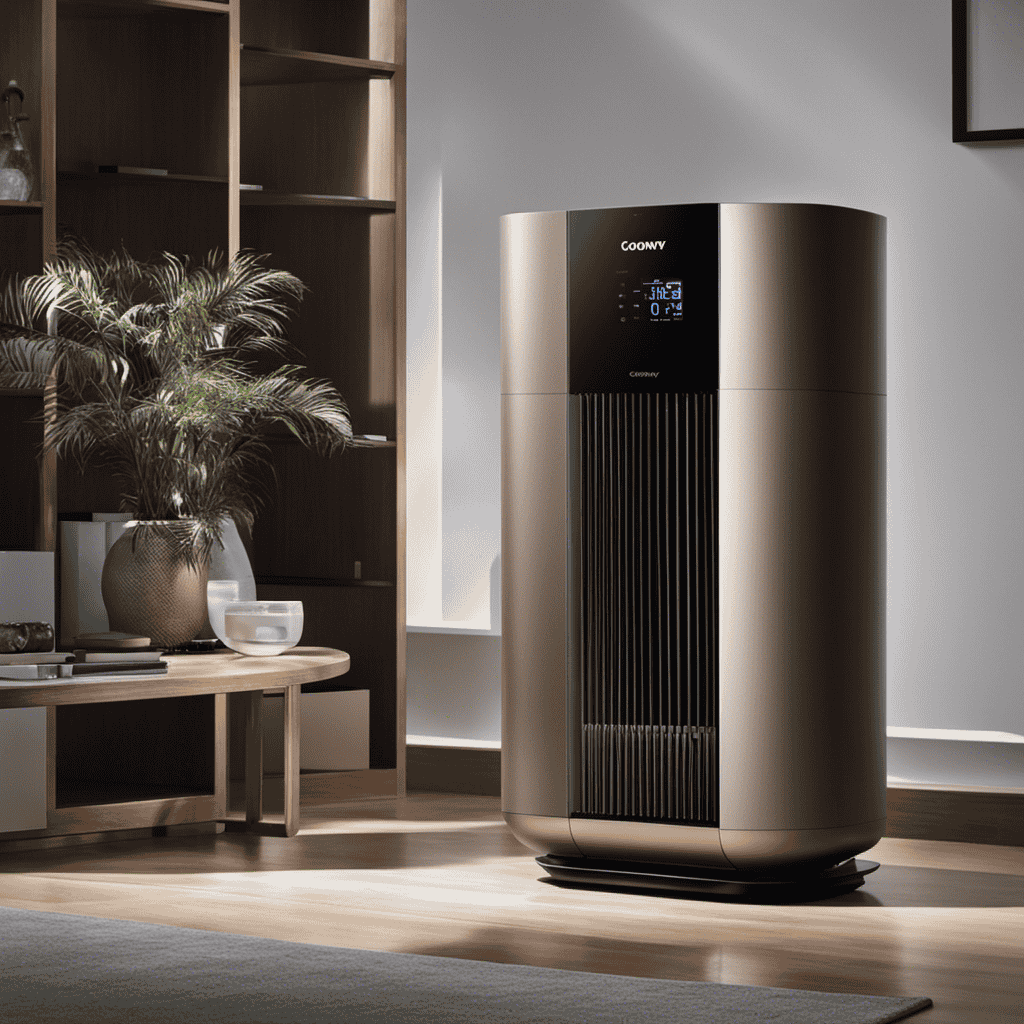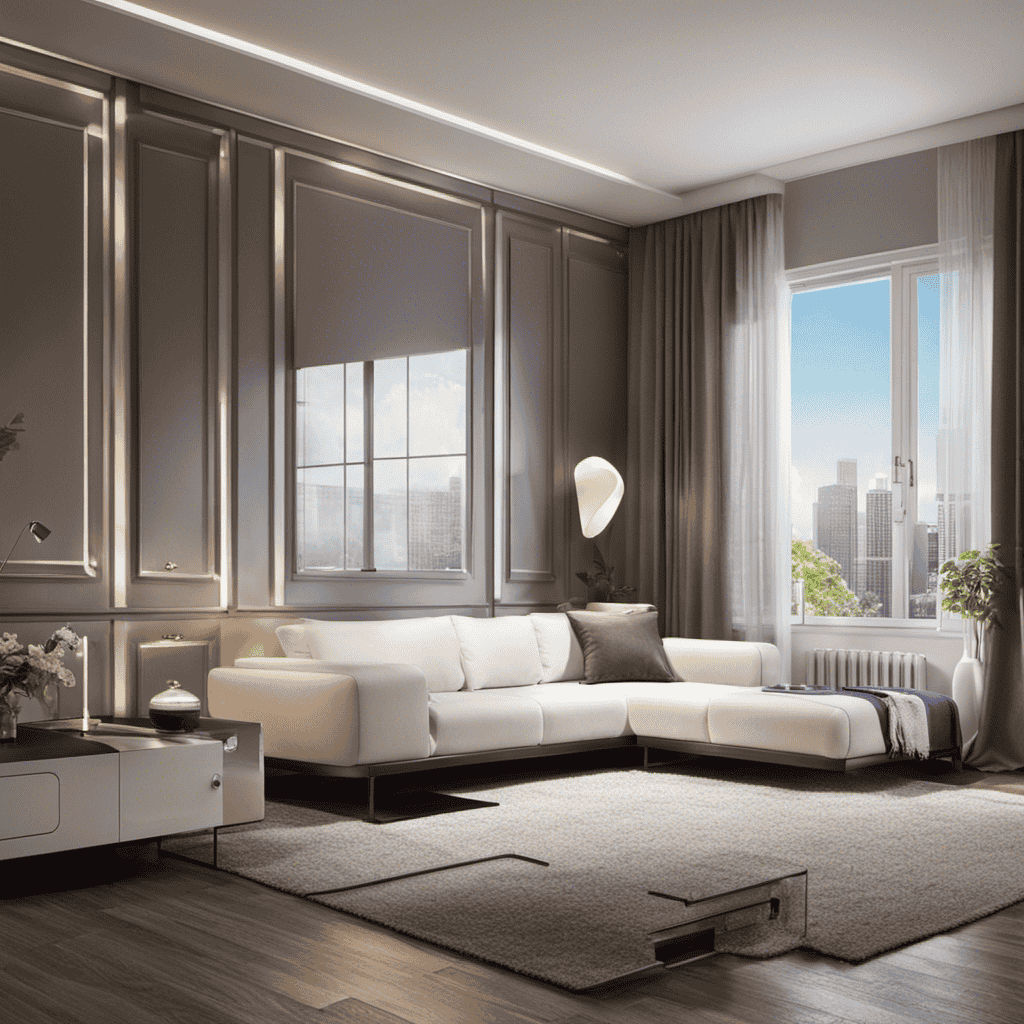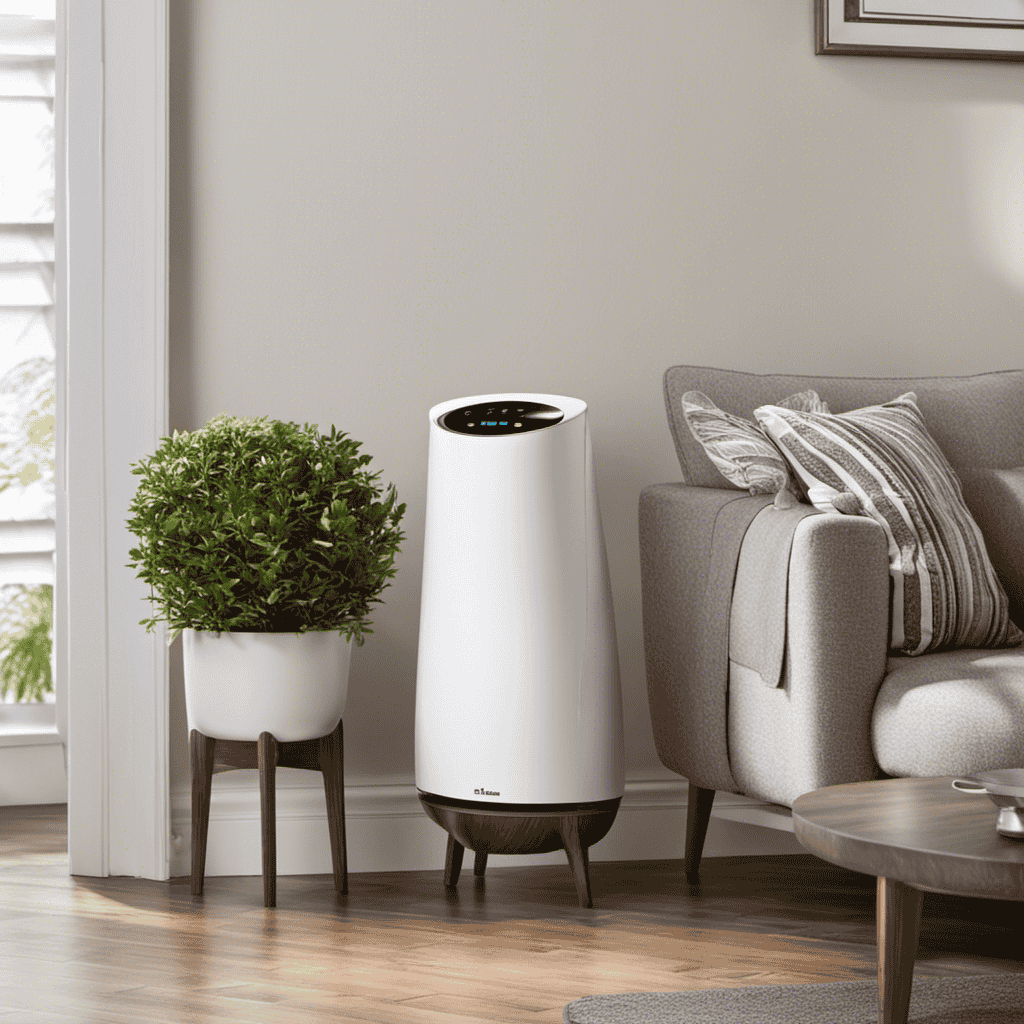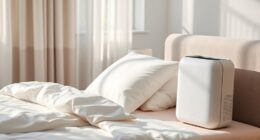I have always been curious about the amount of electricity my air purifier consumes. As a person who is mindful of energy usage, I decided to investigate further and reveal the facts.
In this article, we will explore the factors that affect the electricity usage of air purifiers, measure their power consumption, and compare the efficiency of different models.
So, if you’re curious about cutting down on energy waste without compromising air quality, keep reading.
Key Takeaways
- Factors affecting energy consumption of air purifiers include size of the unit, fan speed setting, duration of usage, and ENERGY STAR certification.
- Energy-saving features of air purifiers include low-energy consumption motors, programmable timers, smart sensors for automatic fan speed adjustment, and sleep mode for quieter and energy-efficient operation.
- Measuring and reducing power consumption of air purifiers can be done through regular cleaning and maintenance, using energy-efficient filters, adjusting fan speed and utilizing timer functions, and sealing air leaks.
- The impact of air purifier size and filter changes on power consumption include increased power consumption due to dirty or clogged filters, the importance of regularly changing filters, and the variation in power consumption based on size, features, and filtration capabilities.
Understanding the Energy Consumption of Air Purifiers
Understanding the energy consumption of air purifiers can help me make informed decisions about my electricity usage. When it comes to measuring energy efficiency, it is important to consider the power consumption of the air purifier.
The amount of electricity used by an air purifier can vary depending on several factors, such as the size of the unit, the fan speed setting, and the duration of usage.
To reduce power consumption, I can choose an air purifier that is ENERGY STAR certified, as these models are designed to be more energy-efficient. Additionally, I can also opt for air purifiers with adjustable fan speeds, allowing me to customize the level of filtration and energy usage based on my needs.
Factors Affecting the Electricity Usage of Air Purifiers
When it comes to air purifiers, understanding the variations in wattage is crucial in assessing their energy consumption. Different models have different power requirements, which directly impact their electricity usage and overall efficiency.
Furthermore, the duration of usage also plays a significant role in determining the energy consumption of air purifiers, as longer operating hours can result in higher electricity usage.
Analyzing these factors can help consumers make informed decisions about the most energy-efficient air purifier for their needs.
Air Purifier Wattage Variations
There’s a significant difference in the wattage of air purifiers available in the market. When measuring efficiency, it is crucial to consider the power consumption of these devices.
Air purifiers with higher wattage tend to have more powerful fans and can clean the air in larger spaces. However, they also consume more electricity, resulting in higher energy costs.
On the other hand, air purifiers with lower wattage may be suitable for smaller rooms but might not be as effective in larger areas.
Conducting a cost analysis is essential to determine the most energy-efficient option that meets your specific needs. By considering the wattage and efficiency of different air purifiers, you can make an informed decision that balances effectiveness and energy consumption.
Impact of Usage Duration
To maximize the lifespan of your air purifier, it’s important to limit its usage duration. Not only does this benefit the longevity of the device, but it also has a significant impact on electricity bills and long-term energy savings.
Air purifiers consume varying amounts of energy depending on their size and features. However, regardless of the specific wattage, reducing the number of hours the purifier runs each day can lead to substantial savings. By using the air purifier only when necessary, such as during peak pollution hours or when allergies are particularly bad, you can minimize unnecessary energy consumption.
This conscientious approach not only helps to lower your monthly electricity bills but also contributes to a more sustainable and eco-friendly lifestyle.
Measuring the Power Consumption of Air Purifiers
When it comes to air purifiers, energy efficiency is a key factor to consider. In this discussion, I will explore the concept of energy-efficient air purifiers and how they can help reduce overall consumption.
Energy-Efficient Air Purifiers
Consider purchasing energy-efficient air purifiers to help reduce your electricity usage.
When it comes to measuring energy efficiency, it is essential to look for air purifiers that have a high CADR (Clean Air Delivery Rate) and a low power consumption. CADR is a measure of how effectively an air purifier can remove pollutants from the air, while power consumption refers to the amount of electricity an air purifier uses to operate.
By choosing an energy-efficient air purifier, you can ensure that you are getting the most out of your device while minimizing its impact on your electricity bill. Additionally, energy-efficient models often come with features such as automatic shut-off timers and sleep modes, further reducing power usage.
Now, let’s explore ways to reduce air purifier consumption.
Reducing Air Purifier Consumption?
When it comes to reducing air purifier consumption, there are a few strategies that can be employed. By optimizing the placement of your air purifier and minimizing the frequency of filter replacement, you can effectively cut down on energy usage. Here are some steps you can take:
-
Strategic Placement: Position your air purifier in an area where it can circulate clean air efficiently. Avoid placing it near walls or furniture that may obstruct airflow.
-
Avoid Obstructions: Keep the space around the air purifier clear of any obstacles that could impede airflow, such as curtains or furniture.
-
Regular Cleaning: Clean the air purifier regularly to prevent dust buildup and ensure optimal performance. This will help maintain air quality and reduce the need for excessive energy consumption.
-
Extend Filter Lifespan: Follow the manufacturer’s guidelines for filter replacement, but also consider using a pre-filter or vacuuming the main filter to prolong its lifespan. This will reduce the frequency of filter replacements and lower energy consumption.
Energy Efficiency Ratings for Air Purifiers
If you want to know how energy-efficient an air purifier is, you can look at its Energy Efficiency Rating. This rating provides valuable information about the device’s energy consumption and efficiency.
Air purifiers with higher ratings are more energy-efficient and can help you save on electricity costs. Additionally, many air purifiers come with energy-saving features that further enhance their efficiency. These features can include programmable timers, smart sensors, and sleep modes.
By incorporating these energy-saving features, air purifiers can optimize their performance while minimizing their energy consumption. Furthermore, air purifiers are subject to energy efficiency standards set by regulatory bodies. These standards ensure that air purifiers meet specific energy efficiency requirements, contributing to a more sustainable and eco-friendly operation.
Comparing the Electricity Usage of Different Air Purifier Models
When it comes to choosing an air purifier, one important factor to consider is its power consumption. Comparing the electricity usage of different air purifier models can help identify the most energy-efficient options.
Power Consumption Comparisons
The power consumption of an air purifier can vary significantly compared to other household appliances. When looking at power usage comparisons, it is important to consider the energy saving features that different models offer.
Here are four key factors to consider:
-
Energy Star Certification: Look for air purifiers that are Energy Star certified. These models are designed to meet strict energy efficiency guidelines, ensuring that they consume less power while still providing effective air purification.
-
Adjustable Fan Speeds: Air purifiers with adjustable fan speeds allow you to customize the power consumption based on your needs. Lower fan speeds consume less electricity, making them ideal for use in smaller rooms or during periods of lower pollution.
-
Timer Function: Having a timer function on your air purifier allows you to set specific operating hours, reducing unnecessary power consumption when the purifier is not needed.
-
Sleep Mode: Some air purifiers come with a sleep mode feature that automatically adjusts the fan speed and reduces power consumption during nighttime hours, ensuring a quiet and energy-efficient operation.
Energy-Efficient Air Purifiers
In the previous subtopic, we discussed the power consumption of different air purifiers. Now, let’s delve into energy-efficient air purifiers and the various features that can help reduce energy usage.
Energy-saving features are becoming increasingly common in air purifiers as manufacturers strive to make their products more environmentally friendly and cost-effective. One such feature is the use of low-energy consumption motors that operate efficiently without compromising on performance. These motors are designed to consume less electricity, resulting in significant energy savings over time.
Another energy-saving feature is the inclusion of programmable timers. These timers allow users to set specific operating hours for the air purifier, ensuring that it only runs when needed. By reducing unnecessary run time, energy consumption is further minimized.
Additionally, some air purifiers come with smart sensors that automatically adjust the fan speed based on the air quality, optimizing energy usage without sacrificing purification effectiveness.
Considering these energy-saving features, it’s important to understand their impact on overall energy consumption.
The Impact of Air Purifier Features on Energy Consumption
Using certain features on an air purifier can affect how much electricity it consumes. When considering energy-saving features and comparing energy usage, there are several key factors to consider:
-
Fan Speed: Higher fan speeds typically consume more energy, so using a lower fan speed can help reduce electricity consumption.
-
Timer Function: Utilizing the timer function allows you to set a specific duration for the air purifier to operate, reducing unnecessary energy usage when the room is unoccupied.
-
Auto Mode: Air purifiers equipped with an auto mode can adjust their fan speed based on the air quality, optimizing energy usage by only running at higher speeds when needed.
-
Sleep Mode: This feature allows the air purifier to operate at a quieter and lower fan speed during nighttime hours, reducing noise and energy consumption.
How to Calculate the Electricity Cost of Running an Air Purifier
When it comes to understanding the energy consumption of an air purifier, there are several factors to consider. These factors include the wattage of the device, the number of hours it is used per day, and the cost of electricity in your area.
Energy Consumption Factors
To reduce your air purifier’s energy consumption, make sure to clean or replace the filters regularly.
Here are four important factors to consider when measuring energy efficiency and reducing power usage:
-
Filter type: Different air purifiers use different types of filters, such as HEPA or activated carbon. Understanding the energy efficiency of each filter type can help you choose the most efficient option.
-
Fan speed: Most air purifiers have multiple fan speed settings. Higher fan speeds consume more energy, so adjusting the fan speed to the lowest effective setting can help reduce power usage.
-
Timer settings: Many air purifiers have built-in timers that allow you to schedule when the device operates. Using the timer to limit the hours of operation can significantly reduce energy consumption.
-
Room size: The size of the room where the air purifier is used affects its energy consumption. Choosing the right-sized air purifier for your room can prevent unnecessary energy usage.
Calculating Electricity Usage
If you’re curious about how many watts your air purifier consumes, you can easily calculate it using the formula: watts = volts x amps. Measuring energy usage is essential for optimizing power consumption and reducing electricity costs. To illustrate this, let’s consider a hypothetical example with three different air purifiers:
| Air Purifier Model | Voltage (V) | Current (A) | Power Consumption (W) |
|---|---|---|---|
| Model A | 120 | 1.5 | 180 |
| Model B | 110 | 1.2 | 132 |
| Model C | 115 | 1.8 | 207 |
Cost-Saving Tips
Implementing these cost-saving tips can help you reduce energy consumption and save money on your electricity bills. Here are four ways to maximize efficiency and reduce energy costs:
-
Use a programmable thermostat: Set your thermostat to adjust automatically when you’re not at home or during sleeping hours. This will prevent unnecessary energy usage and save you money in the long run.
-
Seal air leaks: Inspect your home for any gaps or cracks around windows, doors, and vents. By sealing these areas, you can prevent drafts and maintain a consistent temperature, reducing the need for your air purifier to work harder.
-
Clean and maintain your air purifier: Regularly clean the filters and components of your air purifier to ensure optimal performance. A well-maintained unit will operate more efficiently and consume less energy.
-
Utilize natural ventilation: Take advantage of natural airflow by opening windows and doors when the weather permits. This will help circulate fresh air and reduce the reliance on your air purifier.
By following these tips, you can lower your energy costs and create a more energy-efficient home.
Now, let’s explore some specific tips for reducing the energy usage of your air purifier.
Tips for Reducing the Energy Usage of Your Air Purifier
You can easily reduce the energy usage of your air purifier by adjusting the fan speed to a lower setting. By doing so, not only will you save on electricity costs, but you will also contribute to reducing noise pollution in your space. Lower fan speeds generate less noise, making it a win-win situation.
Additionally, regular maintenance is crucial to ensure optimal energy efficiency. Cleaning or replacing the air filters regularly will prevent the fan from working harder than necessary to push air through clogged filters. This simple maintenance tip can significantly reduce energy consumption.
Now, let’s explore the relationship between air purifier size and electricity consumption, as it is another important factor to consider when trying to minimize energy usage.
The Relationship Between Air Purifier Size and Electricity Consumption
When choosing an air purifier, it’s important to consider the size of the unit and how it will impact your energy consumption. The size of the air purifier plays a significant role in determining its electricity consumption. Here are four key factors to consider:
-
Motor Power: Larger air purifiers usually have more powerful motors, which consume more electricity. Opt for a unit with a motor size suitable for your needs.
-
Room Coverage: The size of the room and the air purifier’s coverage capacity are directly related. A larger air purifier will consume more electricity to effectively clean the air in a larger space.
-
Fan Speed Settings: Air purifiers with multiple fan speed settings allow you to adjust the airflow according to your needs. Lower fan speeds consume less electricity.
-
Energy-saving Features: Look for air purifiers with energy-saving features like timers and sleep modes. These features help reduce electricity consumption when the air purifier is not needed at full capacity.
Considering these electricity consumption factors and choosing an air purifier with energy-saving features will help optimize your energy usage and reduce costs.
Energy-Saving Modes and Settings for Air Purifiers
Energy-saving modes and settings for air purifiers can significantly reduce power consumption. By optimizing the operation of the air purifier, you can enjoy efficient air purification while minimizing energy usage. Here are some energy-saving tips to consider:
| Energy-Saving Mode | Description |
|---|---|
| Sleep Mode | Reduces fan speed and noise level during nighttime use. |
| Timer Setting | Allows you to schedule the air purifier to turn on and off at specific times. |
| Auto Mode | Automatically adjusts fan speed based on air quality to optimize energy usage. |
| Eco Mode | Lowers power consumption by reducing fan speed and limiting operation time. |
Implementing these settings can help you save energy without compromising on air purification effectiveness. Now, let’s explore real-life examples of air purifier electricity usage.
Real-Life Examples of Air Purifier Electricity Usage
To understand the real-life examples of air purifier electricity usage, it’s helpful to examine different scenarios and their corresponding energy consumption.
Here are four scenarios that demonstrate the range of electricity usage for air purifiers:
-
Small, basic model: This compact air purifier typically consumes around 10-50 watts of power per hour, making it energy-efficient for smaller spaces.
-
Medium-sized model: A mid-range air purifier with additional features, such as multiple fan speeds and a larger coverage area, may consume around 50-100 watts per hour.
-
High-end model with advanced filtration: Air purifiers with HEPA filters and smart sensors can provide superior air quality but may consume more electricity, ranging from 100-200 watts per hour.
-
Industrial-grade air purifier: These powerful units, typically used in large spaces or industrial settings, may consume 200-500 watts per hour due to their high airflow capacity and extensive filtration systems.
The Effect of Air Purifier Filter Changes on Power Consumption
Changing the filters in an air purifier can significantly impact its power consumption. It is important to understand how these changes affect the overall power usage of the device, as it can have a direct impact on your electricity bill.
Measuring power usage is crucial in determining the efficiency of an air purifier and the cost associated with running it. When the filters in an air purifier become dirty or clogged, the device has to work harder to circulate air, resulting in increased power consumption.
Understanding the Energy Star Certification for Air Purifiers
Understanding the Energy Star certification can help consumers identify air purifiers that meet high energy efficiency standards. Here are some key points to consider when it comes to energy star requirements and air purifier energy efficiency standards:
-
Energy Star Certified: Look for the Energy Star logo on air purifiers to ensure they have met the strict energy efficiency guidelines set by the Environmental Protection Agency (EPA).
-
Energy Consumption: Energy Star certified air purifiers use up to 40% less energy than standard models, resulting in significant energy savings over time.
-
Performance: Energy Star certified air purifiers are designed to effectively remove pollutants from the air while minimizing energy usage, ensuring both clean air and energy efficiency.
-
Testing and Verification: To earn the Energy Star certification, air purifiers undergo rigorous testing and verification processes to ensure they meet the required energy efficiency standards.
Understanding these energy star requirements can help consumers make informed decisions when choosing an air purifier that not only improves indoor air quality but also minimizes energy consumption.
Now, let’s explore the energy consumption of portable vs. whole-house air purifiers.
Energy Consumption of Portable Vs. Whole-House Air Purifiers
When it comes to energy consumption, you’ll find a noticeable difference between portable and whole-house air purifiers. Measuring energy consumption is an important factor to consider when choosing an air purifier, as it directly impacts your electricity bill.
Portable air purifiers are typically designed for small spaces and have lower energy requirements compared to whole-house air purifiers, which are designed to clean the air in an entire house.
To save costs on energy consumption, there are a few cost-saving strategies you can employ. First, consider the size of the space you want to purify and choose an appropriately sized air purifier. Additionally, look for air purifiers with energy-saving features such as programmable timers and sleep mode, which can help reduce energy consumption when the purifier is not needed.
Overall, it is important to consider the energy consumption of air purifiers and implement cost-saving strategies to reduce your electricity bill.
How to Choose an Energy-Efficient Air Purifier
To choose an energy-efficient air purifier, you should consider factors such as the size of your space, the purifier’s energy-saving features, and its overall performance. Here are some tips for finding the best energy efficient air purifier models and reducing energy usage:
-
Size: Select an air purifier that is appropriate for the size of your room. A purifier that is too large will waste energy, while one that is too small may not effectively clean the air.
-
Energy-saving features: Look for purifiers with features such as programmable timers, sleep mode, and auto-shutoff. These functions can help conserve energy when the air quality is already clean.
-
Filter type: Consider purifiers with high-efficiency particulate air (HEPA) filters, which capture small particles efficiently and require less energy to operate compared to other filter types.
-
Energy Star certification: Opt for air purifiers that are Energy Star certified. These models meet strict energy efficiency guidelines set by the Environmental Protection Agency (EPA) and can help you save on energy costs.
Is a Honeywell Air Purifier More Energy Efficient Than Other Brands?
When it comes to honeywell air purifier electricity usage, Honeywell does a great job of being energy efficient. Compared to other brands, Honeywell air purifiers are designed to consume less electricity, making them a more cost-effective and environmentally friendly option for cleaner indoor air.
Frequently Asked Questions
Can an Air Purifier Be Used With Solar Power or Alternative Energy Sources?
Using solar power for air purifiers and other alternative energy sources provides numerous benefits. It reduces reliance on traditional electricity, lowers carbon emissions, and promotes sustainability. It’s a smart choice for environmentally conscious individuals.
Are There Any Air Purifiers That Use Rechargeable Batteries Instead of Electricity?
Rechargeable battery air purifiers offer the benefits of using alternative energy. They can be a great option for reducing electricity consumption. However, it’s important to consider the power requirements and battery life before making a decision.
How Much Electricity Does an Air Purifier Consume When It Is on Standby Mode?
When an air purifier is in standby mode, its power consumption varies depending on the model and energy efficiency. It is important to consider the standby power consumption when evaluating the overall electricity usage of an air purifier.
Are There Any Air Purifiers That Have a Timer Feature to Automatically Turn off When Not Needed?
There are energy efficient air purifiers on the market that have a timer feature. This allows them to automatically turn off when not needed, saving electricity and providing convenience to the user.
Is It Possible to Use a Power Strip or Surge Protector With an Air Purifier to Save Energy?
Yes, it is possible to use a power strip or surge protector with an air purifier to save energy. This is one of the energy-saving tips for air purifiers.
Conclusion
In conclusion, understanding the energy consumption of air purifiers is crucial in making an informed decision about which model to choose. Factors such as the size of the room, usage time, and filter changes can significantly impact electricity usage.
Comparing energy efficiency ratings and looking for Energy Star certification can help identify more energy-efficient options. Whether opting for a portable or whole-house air purifier, selecting an energy-efficient model is key to reducing electricity consumption and saving on energy costs.
So, before making a purchase, remember to consider the energy efficiency of an air purifier to keep your space clean and your energy bills low.










